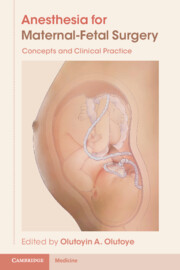Book contents
- Anesthesia for Maternal-Fetal Surgery
- Anesthesia for Maternal-Fetal Surgery
- Copyright page
- Dedication
- Contents
- Contributors
- Abbreviations
- Preface
- Acknowledgments
- Section 1
- Section 2
- Chapter 6 Twin-Twin Transfusion Syndrome
- Chapter 7 Fetal Endoscopic Tracheal Occlusion (FETO)
- Chapter 8 Fetal Cardiac Intervention
- Chapter 9 Antepartum Fetal Monitoring
- Section 3
- Index
- Endmatter
- References
Chapter 8 - Fetal Cardiac Intervention
from Section 2
Published online by Cambridge University Press: 19 November 2021
- Anesthesia for Maternal-Fetal Surgery
- Anesthesia for Maternal-Fetal Surgery
- Copyright page
- Dedication
- Contents
- Contributors
- Abbreviations
- Preface
- Acknowledgments
- Section 1
- Section 2
- Chapter 6 Twin-Twin Transfusion Syndrome
- Chapter 7 Fetal Endoscopic Tracheal Occlusion (FETO)
- Chapter 8 Fetal Cardiac Intervention
- Chapter 9 Antepartum Fetal Monitoring
- Section 3
- Index
- Endmatter
- References
Summary
Fetal cardiac intervention provides fetuses with certain cardiac anomalies, a greater likelihood of biventricular circulation and/or treatment options after delivery. Anesthesia care for mothers undergoing fetal cardiac intervention has evolved over the years and more recently involves the use of neuraxial anesthesia with sedation. The maternal fetal anesthesiologist caring for the patient undergoing fetal cardiac intervention should be conversant with the diagnosis, pathophysiology, and planned intervention. This is important for appropriate anticipation and treatment of hemodynamic changes that may occur in the fetus immediately following intervention.
Keywords
- Type
- Chapter
- Information
- Anesthesia for Maternal-Fetal SurgeryConcepts and Clinical Practice, pp. 103 - 118Publisher: Cambridge University PressPrint publication year: 2021



